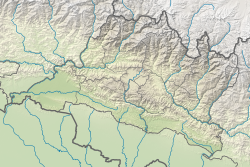| Bhairabi Temple | |
|---|---|
 | |
| Religion | |
| Affiliation | Hinduism |
| District | Nuwakot District |
| Province | Bagmati |
| Deity | Bhairavi |
| Festivals | Dashain |
| Location | |
| Location | Bidur Municipality |
| Country | Nepal |
| Geographic coordinates | 27°54′45″N85°09′50″E / 27.91257330073942°N 85.16375186596684°E |
Bhairabi Temple is a Hindu temple in Bidur Municipality, Nuwakot, Nepal. [1] It is dedicated to goddess Bhairavi, the consort of god Bhairav. It lies about 200m south from the seven storied palace. This temple is also known by the name of Gandaki bhairavi getting its name from the Trishuli Gandaki River. [2]
Contents
The April 2015 Nepal earthquake devastated the Bhairabi Temple and it was restored in August 2020. [3]

